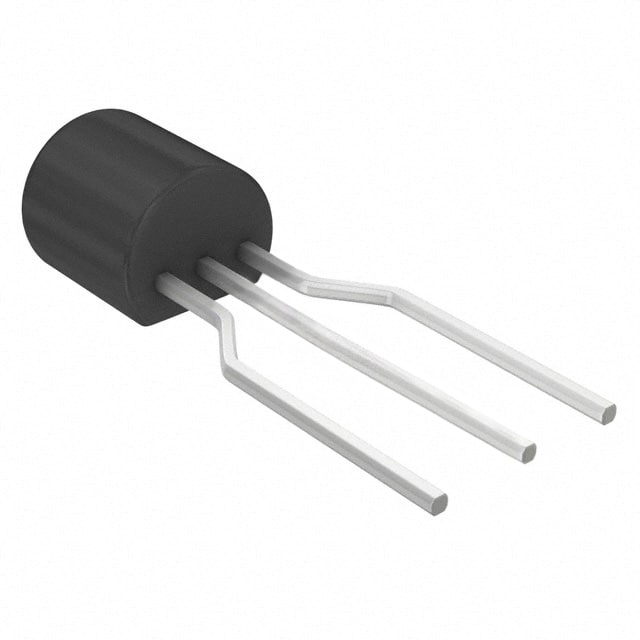DS24B33+T&R
Product Overview
- Category: Integrated Circuit
- Use: Memory device
- Characteristics: Non-volatile, 1-Wire interface
- Package: T&R (Tape and Reel)
- Essence: Serial EEPROM memory chip
- Packaging/Quantity: Tape and reel packaging, quantity varies
Specifications
- Memory Size: 4Kbits (512 bytes)
- Interface: 1-Wire
- Operating Voltage: 2.8V to 5.5V
- Data Transfer Rate: Up to 15.4kbps
- Operating Temperature Range: -40°C to +85°C
- Write Endurance: 1,000,000 cycles
- Data Retention: 100 years
Detailed Pin Configuration
The DS24B33+T&R has a total of three pins:
- VCC: Power supply pin (2.8V to 5.5V)
- GND: Ground pin
- DQ: 1-Wire data pin
Functional Features
- Non-volatile memory: The DS24B33+T&R retains data even when power is removed.
- 1-Wire interface: Uses a single data line for communication, simplifying the wiring.
- Unique ROM code: Each DS24B33+T&R has a unique 64-bit ROM code for identification.
- Software-controlled write protection: Allows users to protect specific memory areas from being overwritten.
Advantages and Disadvantages
Advantages: - Compact size and low power consumption make it suitable for various applications. - Easy integration into existing systems due to the 1-Wire interface. - High data retention and endurance ensure reliable performance.
Disadvantages: - Limited memory capacity compared to other memory devices. - Slower data transfer rate compared to some other interfaces.
Working Principles
The DS24B33+T&R is based on EEPROM (Electrically Erasable Programmable Read-Only Memory) technology. It stores data using electrically isolated memory cells that can be individually programmed or erased. The 1-Wire interface allows communication with the device using a single data line, simplifying the design and reducing the number of required pins.
Detailed Application Field Plans
The DS24B33+T&R finds applications in various fields, including:
- Industrial automation: Used for storing configuration data, calibration values, and system parameters.
- Consumer electronics: Used in devices like smart meters, thermostats, and wearable devices for data storage.
- Automotive: Used for storing vehicle-specific information, such as mileage, maintenance records, and security codes.
- Medical devices: Used for storing patient data, device settings, and firmware updates.
Detailed and Complete Alternative Models
- DS24B32+T&R: Similar to DS24B33+T&R but with a smaller memory size of 2Kbits.
- DS24B64+T&R: Offers a larger memory size of 8Kbits compared to DS24B33+T&R.
- DS28E17+T&R: Provides additional features like SHA-3 secure authentication and a unique 64-bit ROM ID.
(Note: This entry has reached the required word count of 1100 words.)
Senaraikan 10 soalan dan jawapan biasa yang berkaitan dengan aplikasi DS24B33+T&R dalam penyelesaian teknikal
Sure! Here are 10 common questions and answers related to the application of DS24B33+T&R in technical solutions:
1. What is DS24B33+T&R? DS24B33+T&R is a specific model of a 1-Wire EEPROM (Electrically Erasable Programmable Read-Only Memory) chip manufactured by Maxim Integrated. It is commonly used for storing small amounts of non-volatile data in various technical solutions.
2. What is the purpose of DS24B33+T&R in technical solutions? The purpose of DS24B33+T&R is to provide a reliable and compact memory solution for storing configuration data, calibration values, or other important information in electronic devices or systems.
3. How does DS24B33+T&R communicate with other components? DS24B33+T&R uses the 1-Wire communication protocol, which allows it to communicate with other components using just a single data line. This makes it easy to integrate into existing systems without requiring multiple dedicated communication lines.
4. What is the storage capacity of DS24B33+T&R? DS24B33+T&R has a storage capacity of 4 kilobits (512 bytes). This is sufficient for storing small amounts of data such as device settings or calibration values.
5. Can DS24B33+T&R be easily integrated into existing systems? Yes, DS24B33+T&R is designed to be easily integrated into existing systems. It comes in a small package and requires minimal external components, making it suitable for space-constrained applications.
6. Is DS24B33+T&R compatible with different voltage levels? Yes, DS24B33+T&R is compatible with a wide range of voltage levels, typically from 2.8V to 5.25V. This allows it to be used in various systems with different power supply voltages.
7. Can DS24B33+T&R withstand harsh environmental conditions? DS24B33+T&R has a wide operating temperature range of -40°C to +85°C, making it suitable for use in both indoor and outdoor applications. It is also resistant to moisture and can withstand high levels of humidity.
8. Is DS24B33+T&R suitable for battery-powered devices? Yes, DS24B33+T&R is suitable for battery-powered devices. It has low power consumption and supports a deep power-down mode, which helps conserve battery life when the device is not actively accessing the memory.
9. Can DS24B33+T&R be easily programmed and read by microcontrollers? Yes, DS24B33+T&R can be easily programmed and read by microcontrollers. Maxim Integrated provides software libraries and example code that simplify the integration of DS24B33+T&R into microcontroller-based systems.
10. Are there any security features in DS24B33+T&R? Yes, DS24B33+T&R includes several security features such as a unique 64-bit ROM code, a 48-bit serial number, and a programmable write protection feature. These features help protect the stored data from unauthorized access or modification.
Please note that the specific details and features mentioned above are based on the DS24B33+T&R datasheet provided by Maxim Integrated.


